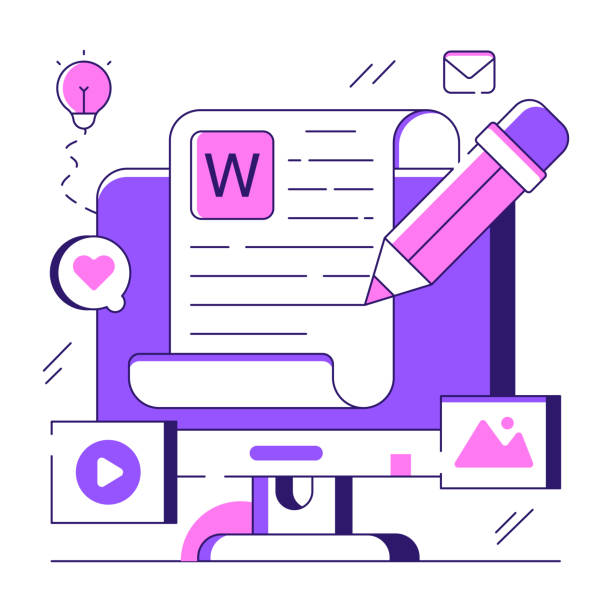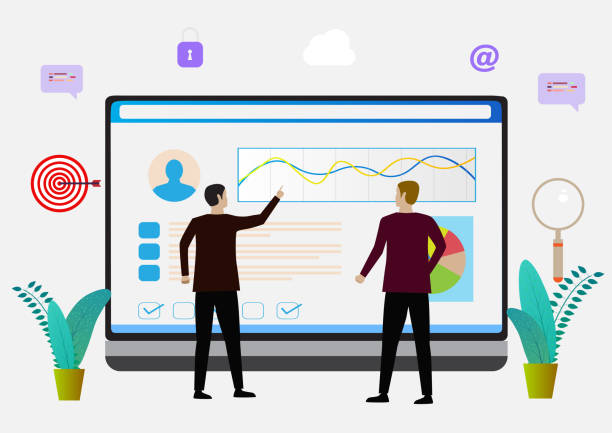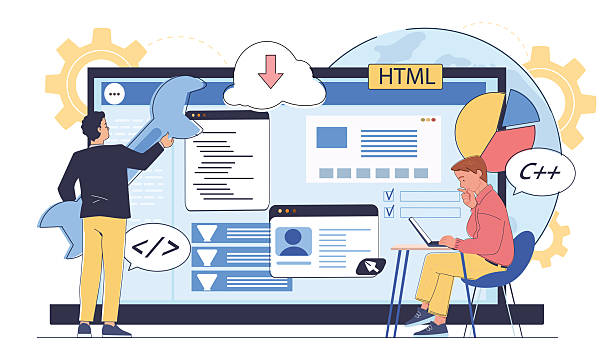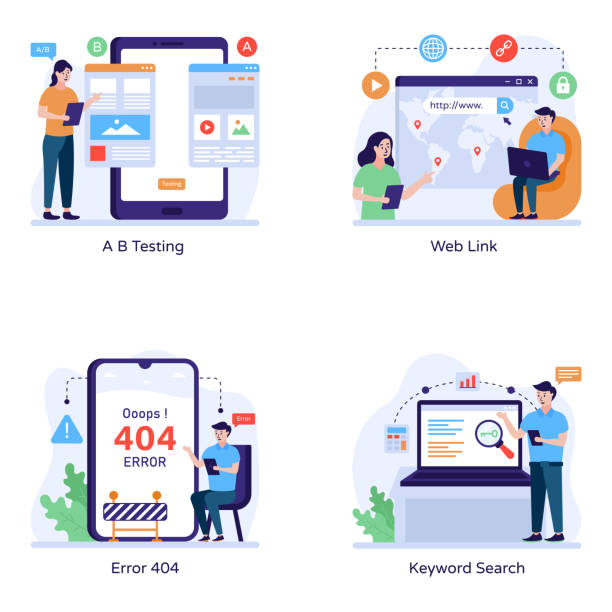The Importance of Fast Website Design in Today’s World

In the current digital age, speed is paramount.
Every second of delay in website loading can mean losing potential users and customers.
Fast website design is no longer a luxury option, but a competitive necessity.
Today’s users are impatient and expect websites to load immediately.
Studies show that more than half of users leave a website that takes more than three seconds to load.
This statistic indicates that #website_speed is a critical factor in your #user_experience and #online_business_success.
A slow website not only drives users away but also negatively impacts your #SEO_ranking.
Search engines like Google consider page load speed as an important factor in website ranking.
Therefore, if you are looking for a strong and successful online presence, investing in fast website design and its continuous optimization is inevitable.
This explanatory and comprehensive article delves into various aspects of website speed and provides practical solutions to achieve it.
Does your current corporate website not reflect your brand’s credibility and power as it should? Rasaweb solves this challenge for you with professional corporate website design.
✅ Increase credibility and visitor trust
✅ Targeted attraction of more customers
⚡ Click to receive a free consultation!
Key Principles for Achieving Fast Page Loading

To achieve fast and optimized website design, understanding its fundamental principles is essential.
These principles include optimizing server-side and client-side codes, file compression, and resource management.
One of the most important actions is image optimization.
Large images are major factors in slowing down loading speed.
Using next-generation image formats like WebP and compressing images without significant quality loss can have a dramatic impact.
Another principle is code minification.
Removing white spaces, comments, and unnecessary codes from HTML, CSS, and JavaScript files reduces file sizes and increases their processing speed.
Also, using GZIP compression for data transfer from the server to user browsers significantly reduces the volume of sent data.
These educational approaches are the foundation for building a high-performance website and help ensure that each page loads in the shortest possible time.
The more carefully these principles are implemented, the better the user experience will be, and your website will be delivered faster to end-users.
Specialized Techniques for Speed Optimization

In addition to basic principles, there are more specialized techniques for increasing website loading speed that are used in professional fast website design.
One such technique is the use of a Content Delivery Network (CDN).
CDN stores your website’s static files on various servers worldwide and allows content to be delivered from the closest server to the end-user, which significantly reduces latency.
Another technique is Caching.
By caching website content, subsequent user visits to the same pages become much faster, as the browser does not need to reload all resources.
Also, Lazy Loading of images and videos means that these elements are only loaded when they are within the user’s viewport, not during the initial page load.
This is especially effective for long pages containing a lot of visual content.
Proper implementation of these techniques requires technical knowledge and careful analysis of the website structure, but the results in improving site performance and speed will be significant.
| Technique | Description | Impact on Speed | Implementation Complexity |
|---|---|---|---|
| Caching | Storing website content in the user’s browser or server for subsequent visits | Very High (especially for returning users) | Medium |
| Content Delivery Network (CDN) | Distributing content across various servers worldwide for faster access | High (reduces latency for distant users) | Medium to High |
| Minification | Removing white spaces and comments from HTML, CSS, JS code | Medium (reduces file size) | Low |
| Lazy Loading | Loading images and videos only when needed | High (reduces initial load) | Medium |
| Image Optimization | Compressing and using new image formats | Very High (significant reduction in page size) | Low to Medium |
Does Beautiful Design Always Mean a Slow Site? A Controversial Question

One of the common questions in web design is whether striking visual design and appealing animations inevitably lead to slower websites? This is a controversial question that many designers and developers face.
The short answer is: No, not necessarily.
A fast website design can be both beautiful and fast simultaneously.
The main challenge lies in balancing aesthetics and performance.
Excessive use of heavy animations, too many fonts, very high-resolution images without optimization, and numerous unnecessary plugins can all lead to website slowness.
However, by adhering to responsive design principles, optimizing codes, and cleverly using loading techniques, beauty can be preserved without sacrificing speed.
For example, using SVG for graphics instead of large pixelated images, or implementing animations with CSS instead of heavy JavaScripts, can help maintain speed.
The goal is to provide a seamless and enjoyable user experience where visual appeal complements speed rather than hindering it.
The belief that one must choose between beauty and speed is a myth and can be resolved with modern approaches.
Are you tired of your e-commerce site not meeting your expectations before customers make a purchase? Don’t worry anymore! With Rasaweb’s professional e-commerce website design services, solve the problem of converting visitors to customers forever!
✅ Significant increase in conversion rates and sales
✅ Unparalleled and engaging user experience
⚡ Contact us now for a free consultation!
Tools and Practical Guides for Measuring Website Speed

To improve website speed, you first need to know its current status.
Various tools are available to guide you in accurately measuring website speed.
Google PageSpeed Insights is one of the most widely used tools that not only provides a speed score but also offers specific suggestions for performance improvement on both mobile and desktop versions.
GTmetrix is another tool that shows deeper details including full load time, total page size, and number of requests.
Also, Lighthouse, which is part of Google Chrome’s developer tools, allows for local inspection of performance, accessibility, best practices, and SEO.
These tools analyze various website elements, identify weaknesses, and provide solutions for optimization.
For example, if PageSpeed Insights suggests image optimization, you know you need to focus on compressing or changing the format of your images.
Regular website speed measurement helps you track your progress and ensure that your fast website design is on the right track.
Technology Updates and the Future of Fast Website Design

The web world is constantly changing, and new technologies are opening new horizons for fast website design.
This section, in a news format, discusses the latest advancements and future trends.
One of the most important is the HTTP/3 protocol, built on QUIC, which promises faster and more reliable connections, even on unstable networks.
This protocol can significantly increase loading speed by reducing communication overhead and improving data flow management.
Another promising technology is WebAssembly (Wasm).
This technology allows developers to execute high-performance code directly in the browser, which can be very useful for complex web applications and heavy computations.
Furthermore, the use of Artificial Intelligence (AI) in website optimization, from intelligent image detection and compression to predicting user behavior and pre-loading content, is expanding.
These innovations show us that the future of web design is moving towards greater speed and efficiency, and fast website design will be available with more powerful tools every day.
The Impact of Website Speed on Business Metrics and SEO (Analytical)

Website speed is more than just a technical factor; it directly impacts business success and search engine rankings.
In this section, we analytically examine these impacts.
Bounce Rate is one of the most important indicators.
The slower the website loads, the higher the probability that users will leave the website before the page fully loads.
This high bounce rate sends a negative signal to search engines.
On the other hand, a fast website design increases the Conversion Rate.
Users access information faster, the purchasing process becomes easier, and consequently, the likelihood of completing the desired action (such as purchase, registration, or download) increases.
From an SEO perspective, Google has explicitly stated that page speed is a ranking factor.
Faster websites appear higher in search results, which means an increase in organic traffic.
Additionally, speed also affects Crawl Budget; search engines can crawl more pages of a fast website within a specified time, leading to faster indexing of new content.
This direct correlation between speed, user experience, and business success highlights the endless importance of fast website design.
| Business Indicator | Impact of High Speed | Why? |
|---|---|---|
| Bounce Rate | Decrease | Users wait less and see content sooner. |
| Conversion Rate | Increase | Smoother user experience and easier completion process (purchase, registration). |
| SEO Ranking | Improvement | Google considers speed as a ranking factor. |
| User Satisfaction | Increase | Positive experience leads to user loyalty and return visits. |
| Page Views | Increase | Users are more inclined to browse other pages on the site. |
Practical Steps to Improve Existing Website Speed (Educational)

If you have an existing website that performs slowly, there’s still an opportunity for improvement.
This educational section provides practical steps to enhance your website’s speed.
The first step is checking the current status using tools like Google PageSpeed Insights.
The reports from this tool identify the main weaknesses.
Then, start optimizing images; use online compression tools or WordPress plugins to reduce image size without significant quality loss.
The next step is minifying and combining CSS and JavaScript files.
Many content management systems have plugins for this purpose.
Ensure that GZIP compression is enabled on your server.
Using caching is also very important; by correctly configuring browser cache and server-side cache, re-loading pages for returning users will be significantly faster.
If your website has high traffic, consider using a CDN.
Finally, choosing a suitable hosting that meets your website’s needs is fundamental for fast website design and optimal performance.
Gradually implementing these steps can bring significant changes to your website’s speed.
Are you tired of your company’s website not meeting your expectations? With Rasaweb, design a professional website that truly represents your business.
✅ Increase attraction of new customers and sales leads
✅ Increase your brand’s credibility and trust among your audience
⚡ Get a free website design consultation now!
Success and Failure Stories in Fast Website Design (Entertaining)

In the world of web, there are many stories of companies that understood the importance of speed and benefited from it, and also cases where neglecting it led to missed opportunities.
This section, with an entertaining approach, discusses these stories.
One of the most famous success stories is Walmart.
This retail giant saw a significant increase in conversion rates with every second of improvement in their site’s loading speed.
They found that reducing load time by just 100 milliseconds could lead to an increase in sales.
This shows that even the smallest optimizations in fast website design can have large financial impacts.
Conversely, many smaller news websites or sales platforms face slowness due to high content volume and lack of proper optimization.
This slowness not only frustrates users but also causes them to quickly move towards faster competitors.
Such stories emphasize that investing in fast website design is not just a technical action but a vital strategy for survival and growth in today’s competitive market.
An optimal user experience stems from website speed and responsiveness.
The Role of Choosing Suitable Hosting in Website Speed

One of the most important factors often overlooked but with a significant impact on website speed is choosing the right hosting service.
Even if you’ve done the best coding and optimizations in your fast website design, poor hosting can nullify all your efforts.
Your hosting is the server that stores your website’s files and responds to user requests.
Server hardware quality, bandwidth, storage type (SSD vs. HDD), and server management all affect loading speed.
For example, inexpensive shared hosting, where server resources are divided among dozens or hundreds of websites, typically perform poorly.
In contrast, Virtual Private Servers (VPS) or dedicated servers provide more resources and offer better performance.
For high-traffic or complex websites, using Cloud Hosting or managed WordPress hosting, which are specifically optimized for speed and scalability, is recommended.
Choosing suitable hosting is an important initial investment that provides the foundation for a fast and stable website design.
Frequently Asked Questions
| Question | Answer |
|---|---|
| What is the concept of fast website design? | It refers to the process of building a website whose pages load at high speed and in minimum time for users. |
| Why is site speed important? | Site speed is crucial for a better user experience, reducing visitor bounce rate, increasing page views, and improving search engine rankings (SEO). |
| What factors affect site loading speed? | Image and file size, unoptimized coding, server speed and location, lack of caching and CDN, and a large number of HTTP requests. |
| What is the role of images in site speed? | Large images can significantly reduce site speed. They should be compressed, optimized, and used in appropriate formats. |
| Is server hosting speed important? | Yes, server response time directly impacts the initial site loading time. Choosing suitable hosting is very important. |
| How does site coding affect speed? | Clean, optimized, minified, and error-free coding reduces file sizes and increases processing speed. |
| How does using Caching (caching) help? | Caching allows the user’s browser to store some site information, so in subsequent visits, there’s no need to reload everything, and the site displays faster. |
| Do extra plugins and scripts slow down the site? | Yes, excessive or improper use of plugins, widgets, and extra scripts can cause site sluggishness. |
| How can site speed be tested? | Using reputable online tools like Google PageSpeed Insights, GTmetrix, or Pingdom Tools. |
| What are the key tips for fast website design? | Image optimization, using CDN, enabling caching, reducing HTTP requests, optimizing CSS and JavaScript, and choosing quality hosting. |
And other services of Rasaweb Advertising Agency in the field of advertising
Smart Reportage: A novel service to increase customer attraction through dedicated programming.
Smart Google Ads: Revolutionize user interaction with the help of intelligent data analysis.
Smart Marketplace: Designed for businesses looking for online growth through intelligent data analysis.
Smart Advertising Campaign: A creative platform to improve customer attraction with Google Ads management.
Smart Direct Marketing: A combination of creativity and technology for user engagement by SEO-driven content strategy.
And over hundreds of other services in the field of internet advertising, advertising consultation, and organizational solutions
Internet Advertising | Advertising Strategy | Advertorial
Resources
Increase WordPress Site Speed
Key Tips for Website Speed Optimization
The Role of Cache in Increasing Website Speed
Image Compression for Fast Websites
? With Rasaweb Afarin, the digital future of your business is in our hands. We guarantee a powerful and influential presence for you by providing comprehensive services in SEO, content marketing, and multilingual website design.
📍 Tehran, Mirdamad Street, next to Bank Markazi, Southern Kazeroon Alley, Ramin Alley, No. 6




